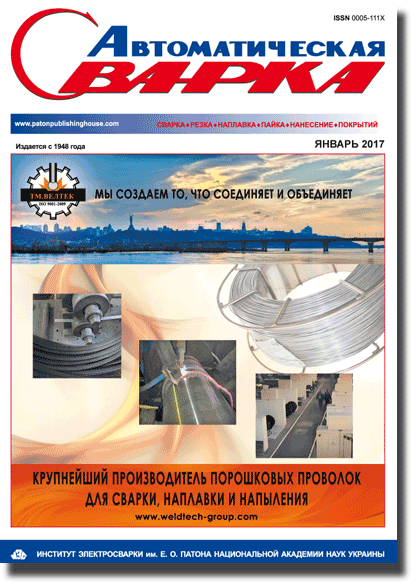| 2017 №01 (03) |
DOI of Article 10.15407/as2017.01.04 |
2017 №01 (05) |

Avtomaticheskaya Svarka (Automatic Welding), #1, 2017, pp. 35-38
Mathematical modeling of chemical composition of welding fumes in manual arc welding with high-alloyed electrodes
O.G. Levchenko1 and O.N. Bezushko2
1NTUU «Igor Sikorsky KPI» 37 Pobedy Prosp., 03056, Kiev, Ukraine
2E.O. Paton Electric Welding Institute, NASU 11 Kazimir Malevich Str., 03680, Kiev, Ukraine. E-mail: office@paton.kiev.ua
Abstract
A mathematical model of convective evaporation of metal from the melt surface was proposed for prediction of the composition of fumes formed in manual arc welding. Numerical analysis of the characteristics of the flow of multicomponent metal vapour in welding with high-alloyed chromium-nickel electrodes was performed. Rates of evaporation of welding fume components at application of electrodes for high-alloyed steel welding were established. Obtained mathematical model enables calculation of not only the relative mass fraction of toxic component in the fume, as it was possible up to now, but also of convective flows of welding fume components. 12 Ref., 2 Tables, 4 Figures.
Keywords: electric arc welding, coated electrodes, welding fumes, chemical composition, evaporation intensity, mathematical modeling
Received: 16.02.17
Published: 17.11.16
References
- Potapov, N.N. (1989) Consumables for arc welding. Vol. 1: Shielding gases and welding fluxes: Refer. Book. Moscow: Mashinostroenie.
- Landau, L.D., Lifshits, E.M. (1976) Theoretical physics. Vol. 5: Statistic physics. Pt 1. Moscow: Nauka.
- Nesmeyanov, A.N. (1961) Vapour pressure of chemical elements. Moscow: AN SSSR.
- (1976) Tables of physical magnitudes: Refer. Book. Ed. by I.K. Kikoin. Moscow: Atomizdat.
- (1969) Course of physical chemistry. Vol. 1. Ed. by Ya.I. Gerasimov. Moscow: Khimiya.
- Knight, C.J. (1979) Theoretical modeling of rapid surface vaporization with back pressure. AIAA J., 17, 519–523. https://doi.org/10.2514/3.61164
- Krivtsun, I.V., Sukhorukov, S.B., Sidorets, V.N. et al. (2008) Modelling of the processes of evaporation of metal and gas dynamics of metal vapour inside a keyhole in laser welding. The Paton Welding J., 10, 16–22.
- Zhao, H., Debroy, T. (2001) Weld metal composition change during conduction mode laser welding of aluminum alloy 5182. and Materials Transact. B, 32B, 163–172. https://doi.org/10.1007/s11663-001-0018-6
- Mundra, K., Debroy, T. (1993) Calculation of weld metal composition change in high-power conduction mode carbon dioxide laser-welded stainless steels. Transact. B, 24B, 145–155. https://doi.org/10.1007/bf02657881
- Yushchenko, K.A., Levchenko, O.G., Bulat, A.V. et al. (2007) Sanitary and hygienic characteristics of covered electrodes for welding high-alloy steels. The Paton Welding J., 12, 35–38.
- Podgaetsky, V.V., Golovatyuk, A.P., Levchenko, O.G. (1989) About mechanism of welding fume formation and prediction of its composition. Svarka, 8, 9–12.
- DSTU ISO 15011-4:2008: Health protection and safety in welding and related processes. Laboratory method of sampling of fumes and gases. Pt 4: Form for fumes data record. Valid from 2008-08–15. Kyiv: Derzhspozyvstandart Ukrainy, 2011.
The cost of subscription/purchase order journals or individual articles
| Journal/Currency | Annual Set | 1 issue printed |
1 issue |
one article |
| TPWJ/USD | 384 $ | 32 $ | 26 $ | 13 $ |
| TPWJ/EUR | 348 € | 29 € | 24 € | 12 € |
| TPWJ/UAH | 7200 UAH | 600 UAH | 600 UAH | 280 UAH |
| AS/UAH | 1800 UAH | 300 UAH | 300 UAH | 150 UAH |
| AS/USD | 192 $ | 32 $ | 26 $ | 13 $ |
| AS/EUR | 180 € | 30 € | 25 € | 12 € |
| SEM/UAH | 1200 UAH | 300 UAH | 300 UAH | 150 UAH |
| SEM/USD | 128 $ | 32 $ | 26 $ | 13 $ |
| SEM/EUR | 120 € | 30 € | 25 € | 12 € |
| TDNK/UAH | 1200 UAH | 300 UAH | 300 UAH | 150 UAH |
| TDNK/USD | 128 $ | 32 $ | 26 $ | 13 $ |
| TDNK/EUR | 120 € | 30 € | 25 € | 15 € |
AS = «Automatic Welding» - 6 issues per year;
TPWJ = «PATON WELDING JOURNAL» - 12 issues per year;
SEM = «Electrometallurgy Today» - 4 issues per year;
TDNK = «Technical Diagnostics and Non-Destructive Testing» - 4 issues per year.





